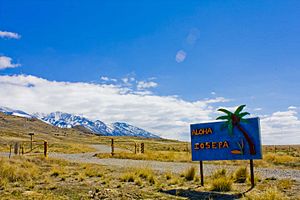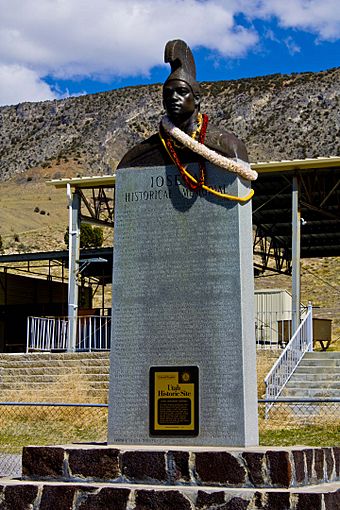Iosepa, Utah facts for kids
Quick facts for kids
Iosepa, Utah
|
|
|---|---|

Welcome sign at entrance to Iosepa historic site, April 2009
|
|
| Country | United States |
| State | Utah |
| County | Tooele |
| Established | 1889 |
| Abandoned | 1917 |
| Named for | Joseph F. Smith |
| Elevation | 4,400 ft (1,341 m) |
| GNIS feature ID | 1455148 |
|
Iosepa Settlement Cemetery
|
|

Monument overlooking the Iosepa cemetery
|
|
| Location | Iosepa, Skull Valley |
| NRHP reference No. | 71000856 |
| Added to NRHP | August 12, 1971 |
Iosepa (pronounced yo-SEP-uh) is a ghost town in Skull Valley, Utah. A ghost town is a place that used to be a town but is now empty. It is about 75 miles (120 km) southwest of Salt Lake City in Tooele County.
Iosepa was home to over 200 Polynesian members of the Church of Jesus Christ of Latter-day Saints. They lived there from 1889 to 1917. Today, people gather there every Memorial Day. Islanders and others from all over the Western United States come to remember the town's history.
Contents
History of Iosepa
How Iosepa Started
In the 1850s, the Church of Jesus Christ of Latter-day Saints sent missionaries to Polynesia. Many people who joined the Church wanted to move to Utah. They wanted to be with the main group of Church members. However, laws in places like Hawaii made it hard for them to leave.
By 1889, about 75 Native Hawaiians had moved to Salt Lake City. They faced many challenges. They experienced culture shock and were treated badly by some white people. For example, they could not stay in white-owned hotels. Restaurants in Salt Lake City would not serve them.
Church leaders looked for a special place for the Hawaiian people. Most good land around Salt Lake City was already taken.
In 1889, a group of Hawaiians and former missionaries chose a spot. They picked a 1,920-acre (777 ha) area in Skull Valley. This place was known as the Quincy Ranch. It became a gathering place for people from the South Sea Islands.
The new colony was set up as a company. It was called the Iosepa Agriculture and Stock Company. The Church owned this company. The first 46 settlers arrived on August 28, 1889. They drew lots to decide who got which piece of land. August 28 is now called Hawaiian Pioneer Day.
Why the Town Was Named Iosepa
The name Iosepa is the Hawaiian form of Joseph. It was chosen to honor two important people. One was Joseph F. Smith (1838–1918). He was one of the first missionaries to serve the Hawaiian people. The other was his uncle, Joseph Smith (1805–1844). He founded the Latter Day Saint movement.
The main reason the Iosepans came to Utah was to be near the Salt Lake Temple. After the temple opened in 1893, they visited it often. They went there to take part in religious ceremonies.
Life and Growth in Iosepa
Iosepa was a very tough place to live. Most settlers were from Hawaii, which has a warm, tropical climate. Skull Valley is a desert. It was very different from their island homes.
The Iosepans worked very hard to make their new home better. They bought a sawmill and built houses. They also built a church, a school, and a store. They created a large irrigation system. This system brought water from the Stansbury Mountains. It allowed them to water their fields, lawns, and flowerbeds in the desert.
The people grew crops and raised pigs. They even built ponds to raise carp and trout. They tried to adapt their traditional foods. For example, they used flour and cornstarch instead of poi. They also tried growing their own seaweed.
The Iosepa Agricultural and Stock Company managed cattle and sheep. The settlers also built a small reservoir called Kanaka Lake. They could swim there and have lakeside picnics. In 1899, people from other parts of Utah came to Iosepa for Arbor Day. They planted 300 walnut trees, 300 fruit trees, and 100 other trees.
The town became known for its neat streets. These streets were lined with yellow roses. In 1911, Iosepa even won a state award. It was for the "best kept and most progressive city in the state of Utah."
Challenges Faced by the Settlers
Even though the town was well-planned, it struggled. Iosepa never became fully self-sufficient. Church leaders had to use Church money to help pay the town's costs.
The harsh desert environment was hard on the Iosepans' health. Many people got sick and died. Diseases like pneumonia, smallpox, and diphtheria were common. In 1896, there were even three cases of leprosy. A special house was built outside town to keep those with leprosy separate. News reports about the diseases made people in other parts of Utah avoid Iosepa.
Life became even harder after several crop failures. Many men had to find work as miners. They worked in the nearby gold and silver mines. Despite these problems, Iosepa continued to grow. The population grew from about 80 people in 1901 to 228 in 1915. Most residents were Hawaiians. But there were also Samoans, Māori, Portuguese, Scots, and English people.
Why Iosepa Became a Ghost Town
In 1915, Joseph F. Smith was the President of the Church. He announced plans to build a temple in Lā'ie, Hawai'i. This would be the first temple built outside of North America.
The new temple in Hawaii changed everything for Iosepa. Church leaders did not tell the Iosepans to move back to Hawaii. But the Church offered to pay for anyone who wanted to move but could not afford it. Most of Iosepa's residents chose to return to Hawaii.
By January 1917, Iosepa was a ghost town. The land was sold to the Deseret Livestock Company. Today, very little of the original town remains. Only the cemetery and a single fire hydrant are left.
Iosepa's Legacy Today
In 1971, the Iosepa cemetery was added to the National Register of Historic Places. For many years, Iosepa was known for its rows of evenly spaced fire hydrants. These hydrants poked out from the sagebrush. By 2004, only a few building foundations and the cemetery markers remained. The cemetery is surrounded by a chain-link fence. A historical marker tells a short story of the settlement. You can easily reach the site by car.
In 1980, a Memorial Day event was started at Iosepa. A few Polynesian families from Utah, some related to the original Iosepans, cleaned up the cemetery. This started an annual tradition that keeps growing.
In the mid-1980s, the Iosepa Historical Association was formed. This group helps people learn about Utah's Polynesian history. The association works to protect the townsite and organize the yearly festival.
On August 28, 1989, Iosepa's 100th birthday, a special event happened. President Gordon B. Hinckley of The Church of Jesus Christ of Latter-day Saints dedicated a monument at the cemetery. It has a bronze bust of a Polynesian warrior. That year, the Memorial Day celebration became a big three-day weekend luau.
Every Memorial Day weekend, hundreds of people gather at the site. This includes Polynesians and anyone interested in Polynesian history. In 2007, about 1,000 people attended. Restrooms and a large concrete pavilion were added for the 1999 festival. The association plans more improvements for the growing crowds. Camping is encouraged, and visitors are always welcome.
Images for kids





